CRM Technology, Marketing, Customer-Centric Culture & Financial Impact
VerifiedAdded on 2023/06/11
|23
|4116
|454
Report
AI Summary
This report explores the impact of Customer Relationship Management (CRM) technology, marketing capabilities, and customer-centric organizational culture on the financial performance of business organizations. It emphasizes how CRM technology is used to acquire and manage customer data, which is then integrated into marketing strategies and organizational culture. The report reviews literature on customer satisfaction, organizational culture, and the revenue generation model, highlighting the importance of aligning organizational culture with customer preferences and local market conditions. It discusses how CRM aids in gathering customer feedback, improving marketing efforts, and ultimately boosting revenue. The research methodology outlines the approach to investigate these relationships, including research design, data collection, and analysis techniques. The report concludes by underscoring the significance of CRM and customer-centric strategies in achieving financial sustainability and competitive advantage.
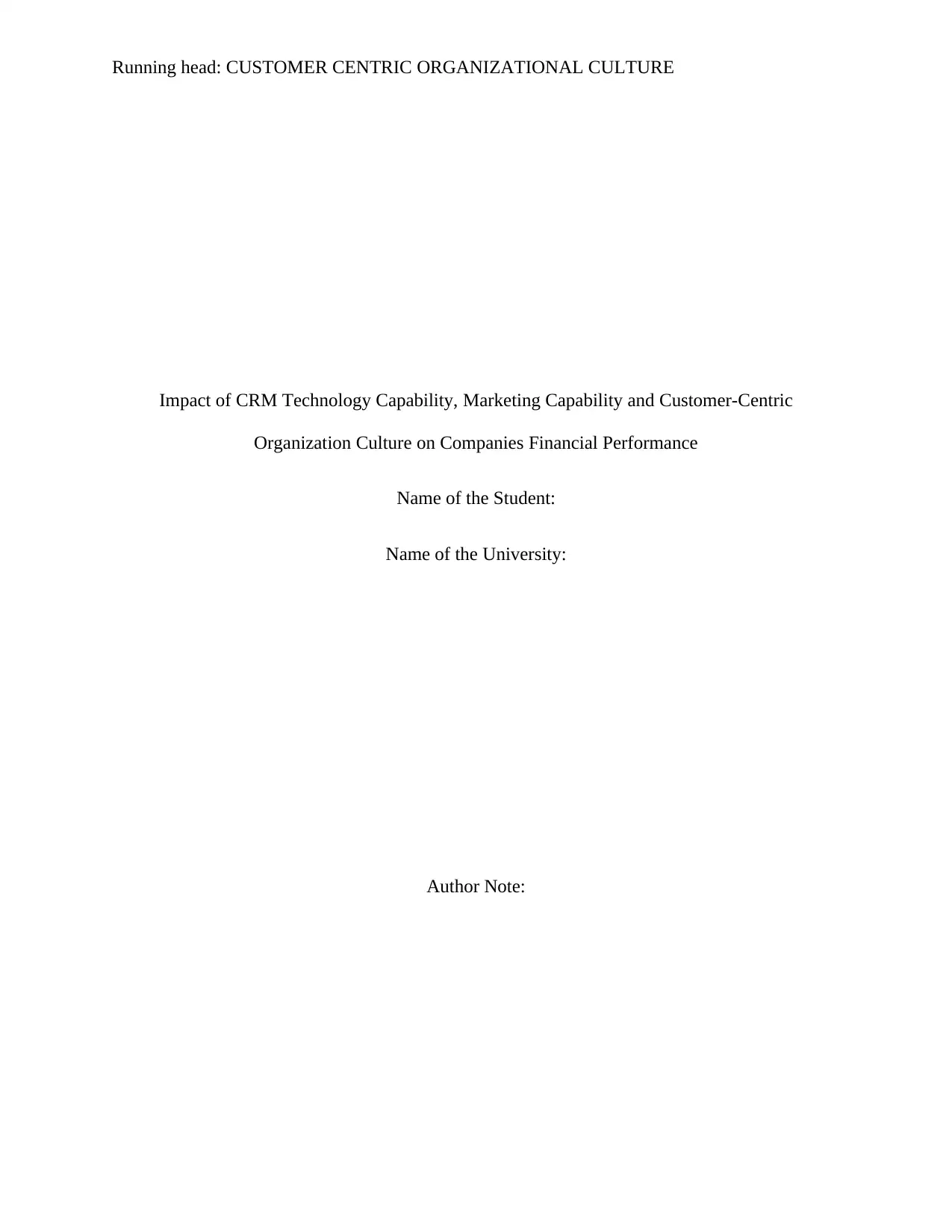
Running head: CUSTOMER CENTRIC ORGANIZATIONAL CULTURE
Impact of CRM Technology Capability, Marketing Capability and Customer-Centric
Organization Culture on Companies Financial Performance
Name of the Student:
Name of the University:
Author Note:
Impact of CRM Technology Capability, Marketing Capability and Customer-Centric
Organization Culture on Companies Financial Performance
Name of the Student:
Name of the University:
Author Note:
Paraphrase This Document
Need a fresh take? Get an instant paraphrase of this document with our AI Paraphraser
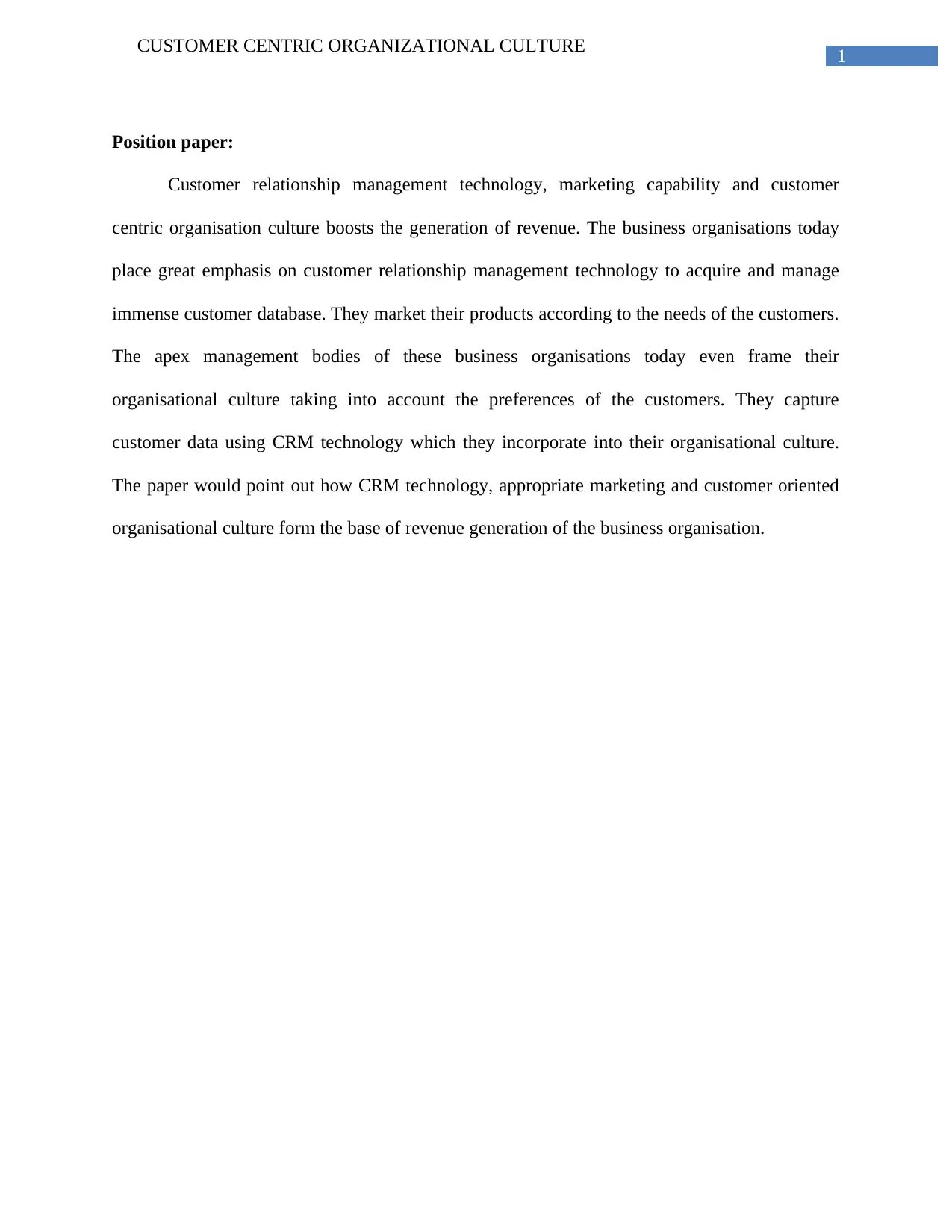
1
CUSTOMER CENTRIC ORGANIZATIONAL CULTURE
Position paper:
Customer relationship management technology, marketing capability and customer
centric organisation culture boosts the generation of revenue. The business organisations today
place great emphasis on customer relationship management technology to acquire and manage
immense customer database. They market their products according to the needs of the customers.
The apex management bodies of these business organisations today even frame their
organisational culture taking into account the preferences of the customers. They capture
customer data using CRM technology which they incorporate into their organisational culture.
The paper would point out how CRM technology, appropriate marketing and customer oriented
organisational culture form the base of revenue generation of the business organisation.
CUSTOMER CENTRIC ORGANIZATIONAL CULTURE
Position paper:
Customer relationship management technology, marketing capability and customer
centric organisation culture boosts the generation of revenue. The business organisations today
place great emphasis on customer relationship management technology to acquire and manage
immense customer database. They market their products according to the needs of the customers.
The apex management bodies of these business organisations today even frame their
organisational culture taking into account the preferences of the customers. They capture
customer data using CRM technology which they incorporate into their organisational culture.
The paper would point out how CRM technology, appropriate marketing and customer oriented
organisational culture form the base of revenue generation of the business organisation.
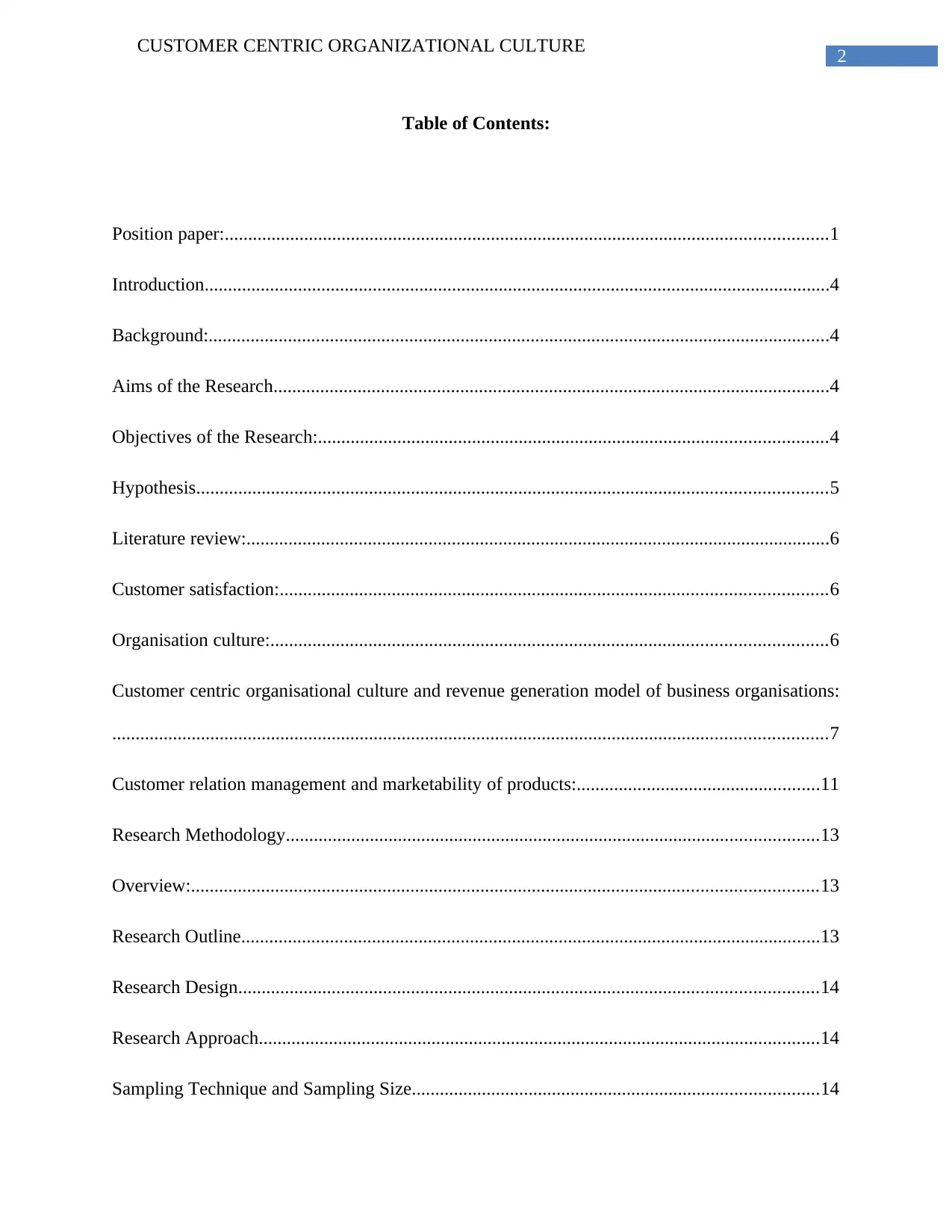
2
CUSTOMER CENTRIC ORGANIZATIONAL CULTURE
Table of Contents:
Position paper:.................................................................................................................................1
Introduction......................................................................................................................................4
Background:.....................................................................................................................................4
Aims of the Research.......................................................................................................................4
Objectives of the Research:.............................................................................................................4
Hypothesis.......................................................................................................................................5
Literature review:.............................................................................................................................6
Customer satisfaction:.....................................................................................................................6
Organisation culture:.......................................................................................................................6
Customer centric organisational culture and revenue generation model of business organisations:
.........................................................................................................................................................7
Customer relation management and marketability of products:....................................................11
Research Methodology..................................................................................................................13
Overview:......................................................................................................................................13
Research Outline............................................................................................................................13
Research Design............................................................................................................................14
Research Approach........................................................................................................................14
Sampling Technique and Sampling Size.......................................................................................14
CUSTOMER CENTRIC ORGANIZATIONAL CULTURE
Table of Contents:
Position paper:.................................................................................................................................1
Introduction......................................................................................................................................4
Background:.....................................................................................................................................4
Aims of the Research.......................................................................................................................4
Objectives of the Research:.............................................................................................................4
Hypothesis.......................................................................................................................................5
Literature review:.............................................................................................................................6
Customer satisfaction:.....................................................................................................................6
Organisation culture:.......................................................................................................................6
Customer centric organisational culture and revenue generation model of business organisations:
.........................................................................................................................................................7
Customer relation management and marketability of products:....................................................11
Research Methodology..................................................................................................................13
Overview:......................................................................................................................................13
Research Outline............................................................................................................................13
Research Design............................................................................................................................14
Research Approach........................................................................................................................14
Sampling Technique and Sampling Size.......................................................................................14
⊘ This is a preview!⊘
Do you want full access?
Subscribe today to unlock all pages.

Trusted by 1+ million students worldwide
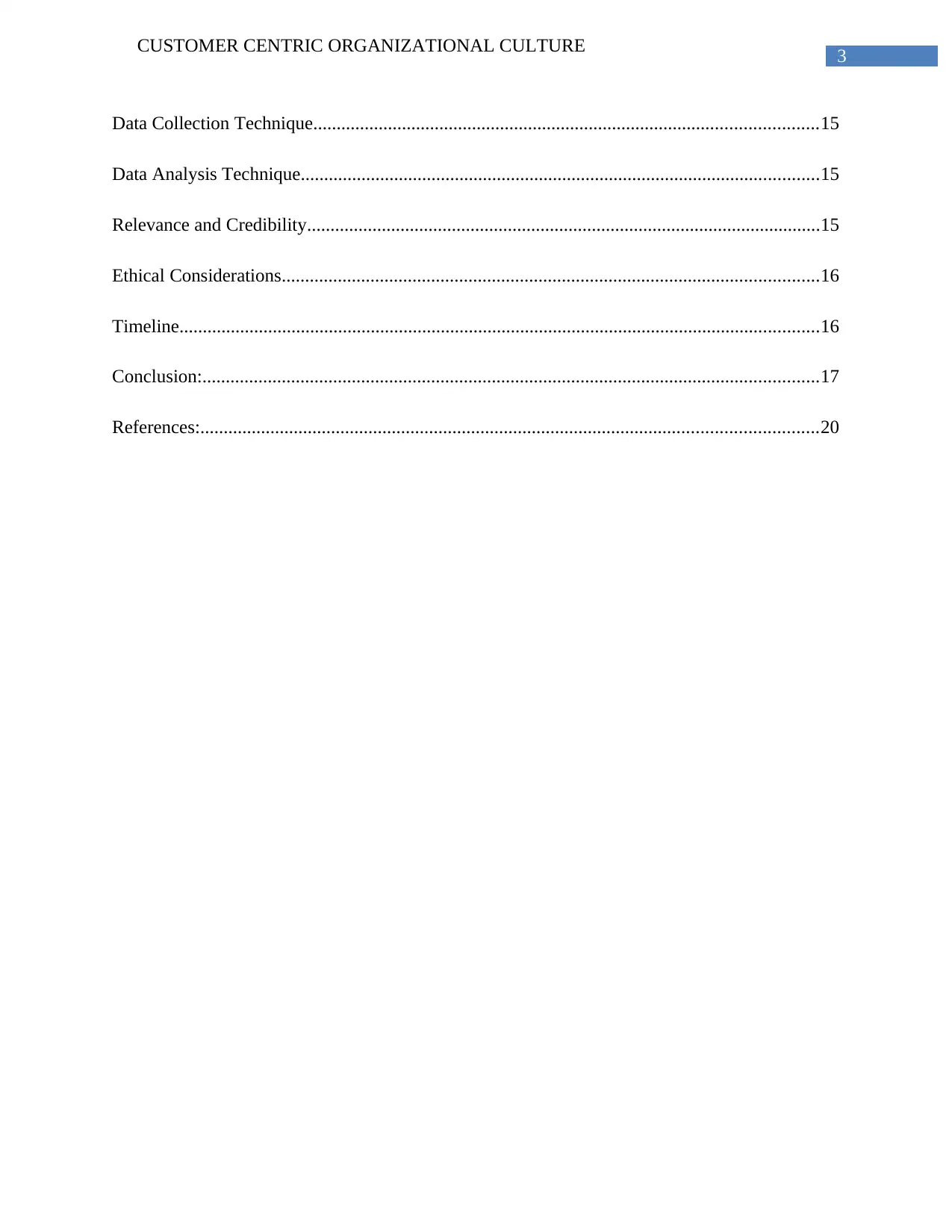
3
CUSTOMER CENTRIC ORGANIZATIONAL CULTURE
Data Collection Technique............................................................................................................15
Data Analysis Technique...............................................................................................................15
Relevance and Credibility..............................................................................................................15
Ethical Considerations...................................................................................................................16
Timeline.........................................................................................................................................16
Conclusion:....................................................................................................................................17
References:....................................................................................................................................20
CUSTOMER CENTRIC ORGANIZATIONAL CULTURE
Data Collection Technique............................................................................................................15
Data Analysis Technique...............................................................................................................15
Relevance and Credibility..............................................................................................................15
Ethical Considerations...................................................................................................................16
Timeline.........................................................................................................................................16
Conclusion:....................................................................................................................................17
References:....................................................................................................................................20
Paraphrase This Document
Need a fresh take? Get an instant paraphrase of this document with our AI Paraphraser
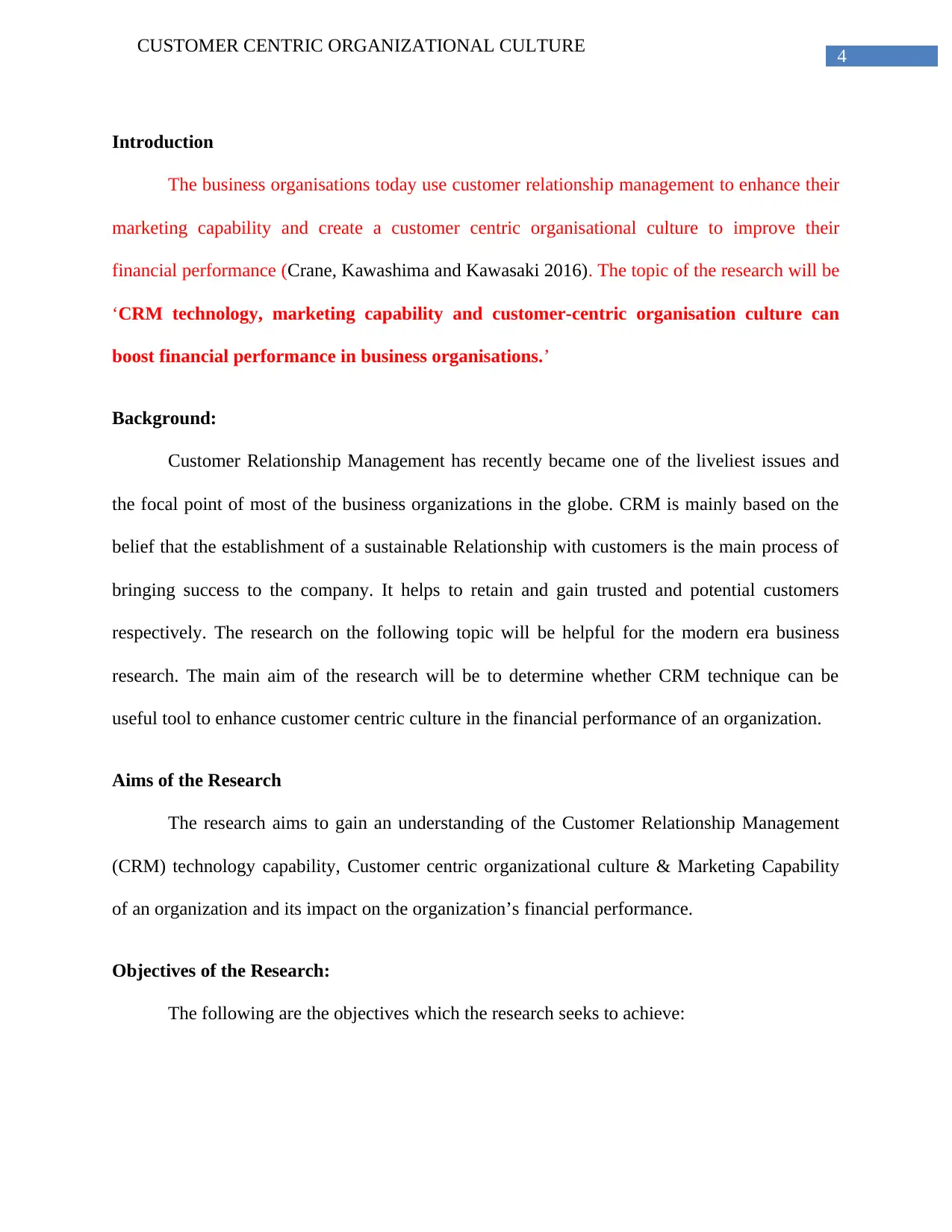
4
CUSTOMER CENTRIC ORGANIZATIONAL CULTURE
Introduction
The business organisations today use customer relationship management to enhance their
marketing capability and create a customer centric organisational culture to improve their
financial performance (Crane, Kawashima and Kawasaki 2016). The topic of the research will be
‘CRM technology, marketing capability and customer-centric organisation culture can
boost financial performance in business organisations.’
Background:
Customer Relationship Management has recently became one of the liveliest issues and
the focal point of most of the business organizations in the globe. CRM is mainly based on the
belief that the establishment of a sustainable Relationship with customers is the main process of
bringing success to the company. It helps to retain and gain trusted and potential customers
respectively. The research on the following topic will be helpful for the modern era business
research. The main aim of the research will be to determine whether CRM technique can be
useful tool to enhance customer centric culture in the financial performance of an organization.
Aims of the Research
The research aims to gain an understanding of the Customer Relationship Management
(CRM) technology capability, Customer centric organizational culture & Marketing Capability
of an organization and its impact on the organization’s financial performance.
Objectives of the Research:
The following are the objectives which the research seeks to achieve:
CUSTOMER CENTRIC ORGANIZATIONAL CULTURE
Introduction
The business organisations today use customer relationship management to enhance their
marketing capability and create a customer centric organisational culture to improve their
financial performance (Crane, Kawashima and Kawasaki 2016). The topic of the research will be
‘CRM technology, marketing capability and customer-centric organisation culture can
boost financial performance in business organisations.’
Background:
Customer Relationship Management has recently became one of the liveliest issues and
the focal point of most of the business organizations in the globe. CRM is mainly based on the
belief that the establishment of a sustainable Relationship with customers is the main process of
bringing success to the company. It helps to retain and gain trusted and potential customers
respectively. The research on the following topic will be helpful for the modern era business
research. The main aim of the research will be to determine whether CRM technique can be
useful tool to enhance customer centric culture in the financial performance of an organization.
Aims of the Research
The research aims to gain an understanding of the Customer Relationship Management
(CRM) technology capability, Customer centric organizational culture & Marketing Capability
of an organization and its impact on the organization’s financial performance.
Objectives of the Research:
The following are the objectives which the research seeks to achieve:
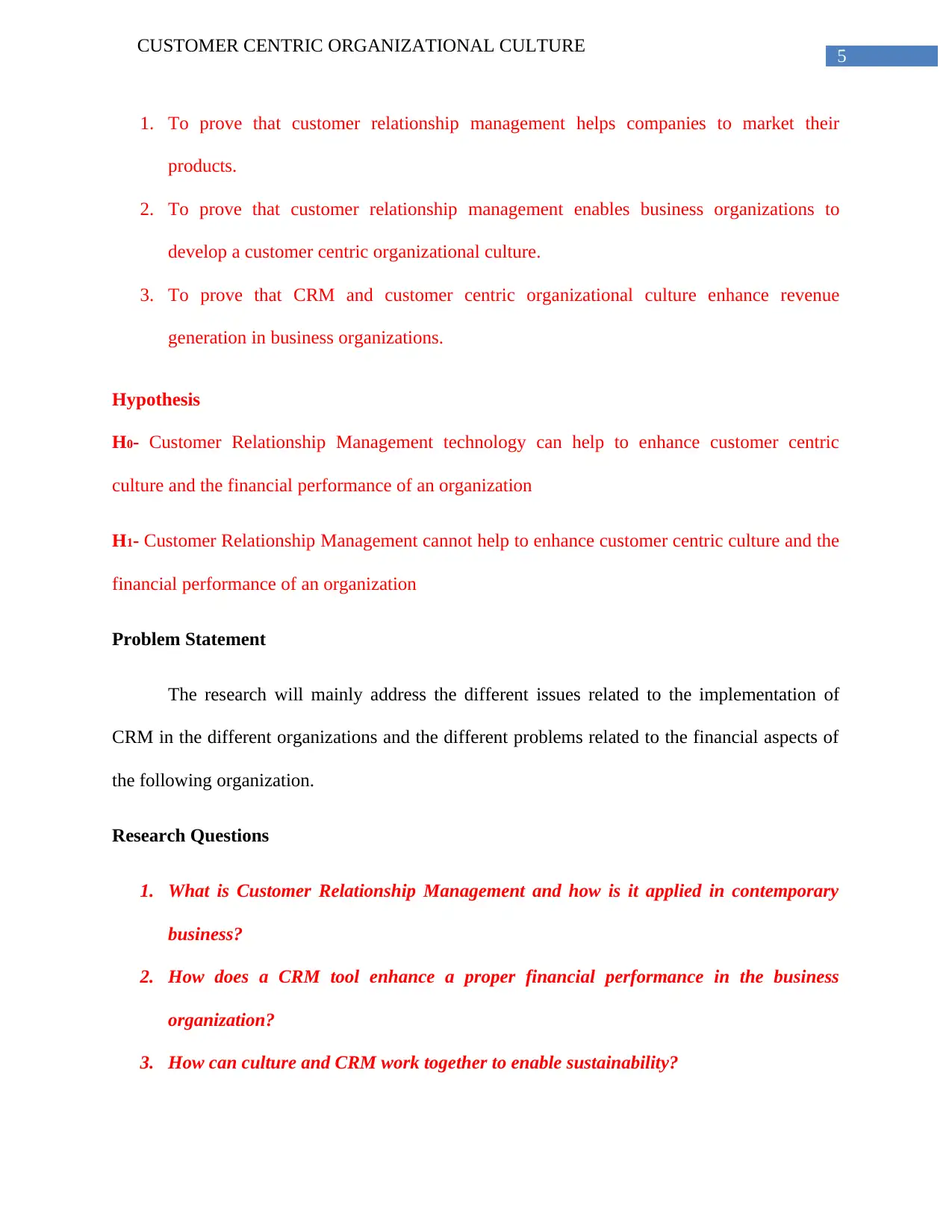
5
CUSTOMER CENTRIC ORGANIZATIONAL CULTURE
1. To prove that customer relationship management helps companies to market their
products.
2. To prove that customer relationship management enables business organizations to
develop a customer centric organizational culture.
3. To prove that CRM and customer centric organizational culture enhance revenue
generation in business organizations.
Hypothesis
H0- Customer Relationship Management technology can help to enhance customer centric
culture and the financial performance of an organization
H1- Customer Relationship Management cannot help to enhance customer centric culture and the
financial performance of an organization
Problem Statement
The research will mainly address the different issues related to the implementation of
CRM in the different organizations and the different problems related to the financial aspects of
the following organization.
Research Questions
1. What is Customer Relationship Management and how is it applied in contemporary
business?
2. How does a CRM tool enhance a proper financial performance in the business
organization?
3. How can culture and CRM work together to enable sustainability?
CUSTOMER CENTRIC ORGANIZATIONAL CULTURE
1. To prove that customer relationship management helps companies to market their
products.
2. To prove that customer relationship management enables business organizations to
develop a customer centric organizational culture.
3. To prove that CRM and customer centric organizational culture enhance revenue
generation in business organizations.
Hypothesis
H0- Customer Relationship Management technology can help to enhance customer centric
culture and the financial performance of an organization
H1- Customer Relationship Management cannot help to enhance customer centric culture and the
financial performance of an organization
Problem Statement
The research will mainly address the different issues related to the implementation of
CRM in the different organizations and the different problems related to the financial aspects of
the following organization.
Research Questions
1. What is Customer Relationship Management and how is it applied in contemporary
business?
2. How does a CRM tool enhance a proper financial performance in the business
organization?
3. How can culture and CRM work together to enable sustainability?
⊘ This is a preview!⊘
Do you want full access?
Subscribe today to unlock all pages.

Trusted by 1+ million students worldwide
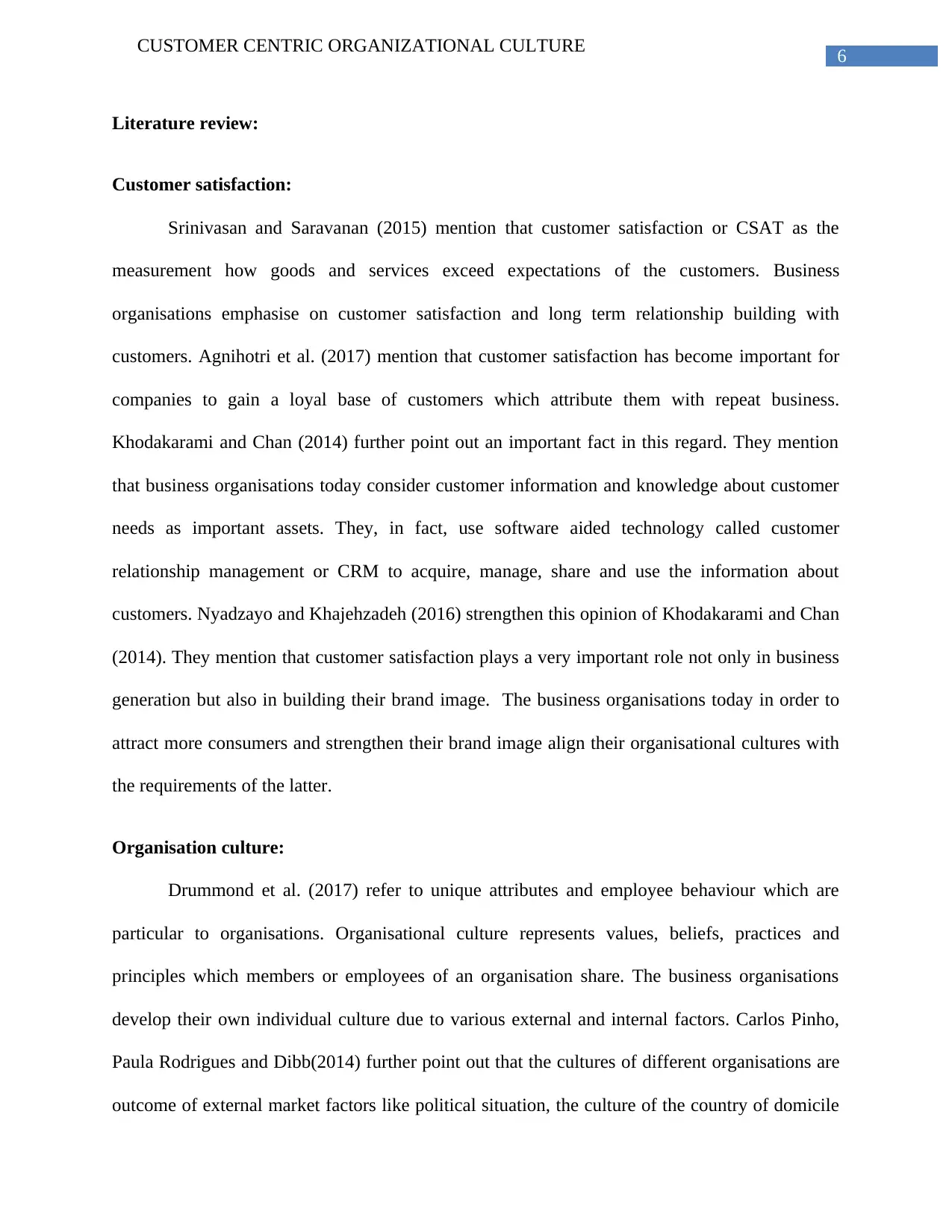
6
CUSTOMER CENTRIC ORGANIZATIONAL CULTURE
Literature review:
Customer satisfaction:
Srinivasan and Saravanan (2015) mention that customer satisfaction or CSAT as the
measurement how goods and services exceed expectations of the customers. Business
organisations emphasise on customer satisfaction and long term relationship building with
customers. Agnihotri et al. (2017) mention that customer satisfaction has become important for
companies to gain a loyal base of customers which attribute them with repeat business.
Khodakarami and Chan (2014) further point out an important fact in this regard. They mention
that business organisations today consider customer information and knowledge about customer
needs as important assets. They, in fact, use software aided technology called customer
relationship management or CRM to acquire, manage, share and use the information about
customers. Nyadzayo and Khajehzadeh (2016) strengthen this opinion of Khodakarami and Chan
(2014). They mention that customer satisfaction plays a very important role not only in business
generation but also in building their brand image. The business organisations today in order to
attract more consumers and strengthen their brand image align their organisational cultures with
the requirements of the latter.
Organisation culture:
Drummond et al. (2017) refer to unique attributes and employee behaviour which are
particular to organisations. Organisational culture represents values, beliefs, practices and
principles which members or employees of an organisation share. The business organisations
develop their own individual culture due to various external and internal factors. Carlos Pinho,
Paula Rodrigues and Dibb(2014) further point out that the cultures of different organisations are
outcome of external market factors like political situation, the culture of the country of domicile
CUSTOMER CENTRIC ORGANIZATIONAL CULTURE
Literature review:
Customer satisfaction:
Srinivasan and Saravanan (2015) mention that customer satisfaction or CSAT as the
measurement how goods and services exceed expectations of the customers. Business
organisations emphasise on customer satisfaction and long term relationship building with
customers. Agnihotri et al. (2017) mention that customer satisfaction has become important for
companies to gain a loyal base of customers which attribute them with repeat business.
Khodakarami and Chan (2014) further point out an important fact in this regard. They mention
that business organisations today consider customer information and knowledge about customer
needs as important assets. They, in fact, use software aided technology called customer
relationship management or CRM to acquire, manage, share and use the information about
customers. Nyadzayo and Khajehzadeh (2016) strengthen this opinion of Khodakarami and Chan
(2014). They mention that customer satisfaction plays a very important role not only in business
generation but also in building their brand image. The business organisations today in order to
attract more consumers and strengthen their brand image align their organisational cultures with
the requirements of the latter.
Organisation culture:
Drummond et al. (2017) refer to unique attributes and employee behaviour which are
particular to organisations. Organisational culture represents values, beliefs, practices and
principles which members or employees of an organisation share. The business organisations
develop their own individual culture due to various external and internal factors. Carlos Pinho,
Paula Rodrigues and Dibb(2014) further point out that the cultures of different organisations are
outcome of external market factors like political situation, the culture of the country of domicile
Paraphrase This Document
Need a fresh take? Get an instant paraphrase of this document with our AI Paraphraser
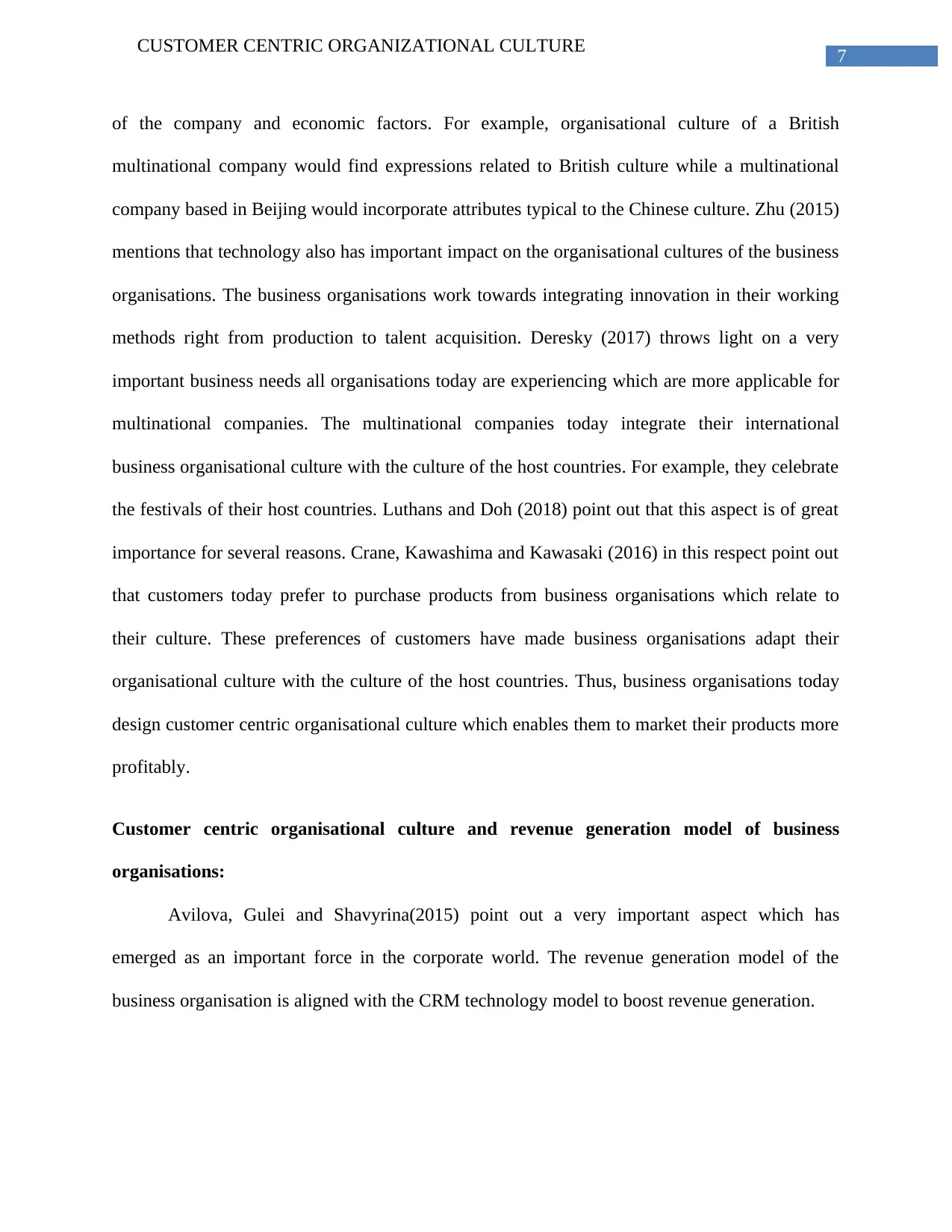
7
CUSTOMER CENTRIC ORGANIZATIONAL CULTURE
of the company and economic factors. For example, organisational culture of a British
multinational company would find expressions related to British culture while a multinational
company based in Beijing would incorporate attributes typical to the Chinese culture. Zhu (2015)
mentions that technology also has important impact on the organisational cultures of the business
organisations. The business organisations work towards integrating innovation in their working
methods right from production to talent acquisition. Deresky (2017) throws light on a very
important business needs all organisations today are experiencing which are more applicable for
multinational companies. The multinational companies today integrate their international
business organisational culture with the culture of the host countries. For example, they celebrate
the festivals of their host countries. Luthans and Doh (2018) point out that this aspect is of great
importance for several reasons. Crane, Kawashima and Kawasaki (2016) in this respect point out
that customers today prefer to purchase products from business organisations which relate to
their culture. These preferences of customers have made business organisations adapt their
organisational culture with the culture of the host countries. Thus, business organisations today
design customer centric organisational culture which enables them to market their products more
profitably.
Customer centric organisational culture and revenue generation model of business
organisations:
Avilova, Gulei and Shavyrina(2015) point out a very important aspect which has
emerged as an important force in the corporate world. The revenue generation model of the
business organisation is aligned with the CRM technology model to boost revenue generation.
CUSTOMER CENTRIC ORGANIZATIONAL CULTURE
of the company and economic factors. For example, organisational culture of a British
multinational company would find expressions related to British culture while a multinational
company based in Beijing would incorporate attributes typical to the Chinese culture. Zhu (2015)
mentions that technology also has important impact on the organisational cultures of the business
organisations. The business organisations work towards integrating innovation in their working
methods right from production to talent acquisition. Deresky (2017) throws light on a very
important business needs all organisations today are experiencing which are more applicable for
multinational companies. The multinational companies today integrate their international
business organisational culture with the culture of the host countries. For example, they celebrate
the festivals of their host countries. Luthans and Doh (2018) point out that this aspect is of great
importance for several reasons. Crane, Kawashima and Kawasaki (2016) in this respect point out
that customers today prefer to purchase products from business organisations which relate to
their culture. These preferences of customers have made business organisations adapt their
organisational culture with the culture of the host countries. Thus, business organisations today
design customer centric organisational culture which enables them to market their products more
profitably.
Customer centric organisational culture and revenue generation model of business
organisations:
Avilova, Gulei and Shavyrina(2015) point out a very important aspect which has
emerged as an important force in the corporate world. The revenue generation model of the
business organisation is aligned with the CRM technology model to boost revenue generation.
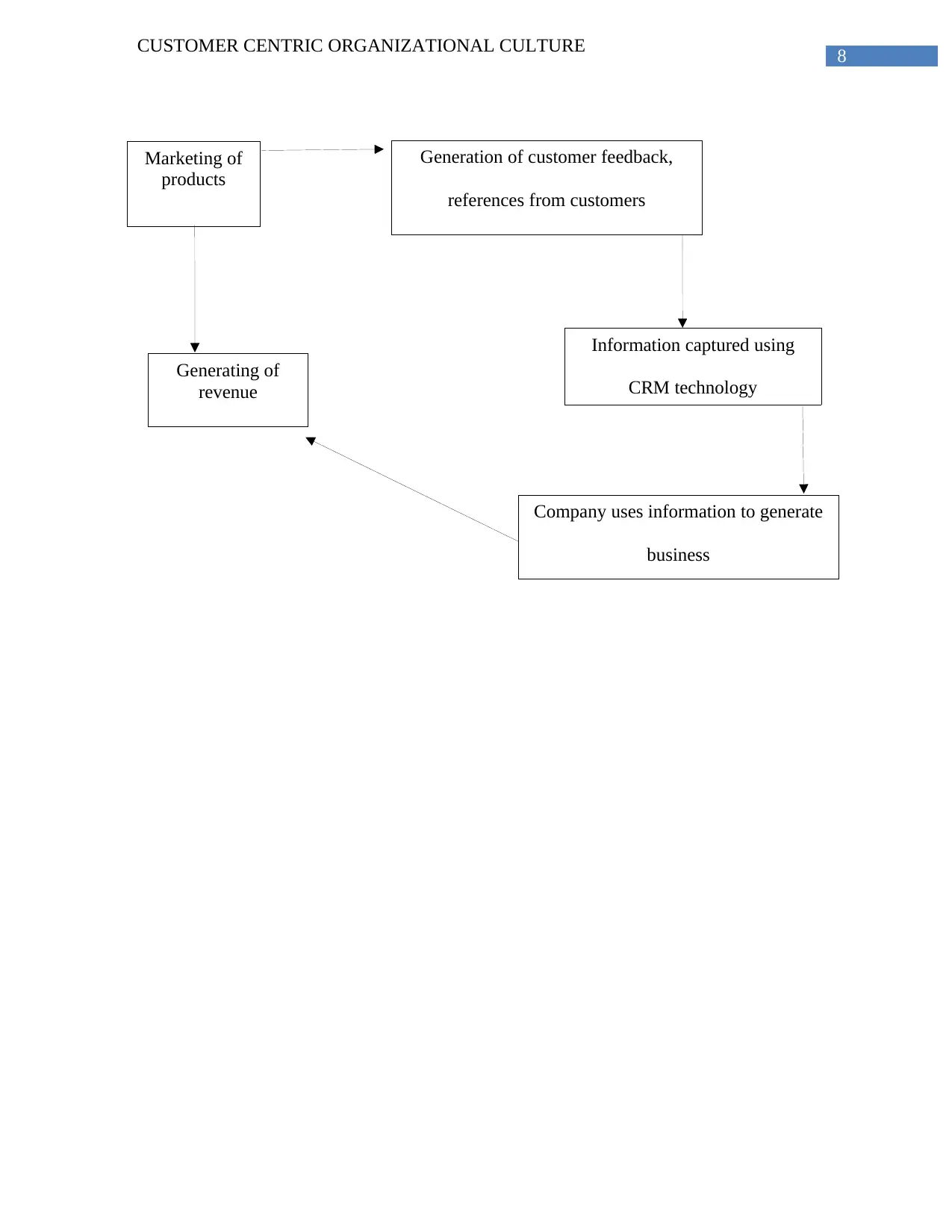
8
CUSTOMER CENTRIC ORGANIZATIONAL CULTURE
Marketing of
products
Generating of
revenue
Generation of customer feedback,
references from customers
Information captured using
CRM technology
Company uses information to generate
business
CUSTOMER CENTRIC ORGANIZATIONAL CULTURE
Marketing of
products
Generating of
revenue
Generation of customer feedback,
references from customers
Information captured using
CRM technology
Company uses information to generate
business
⊘ This is a preview!⊘
Do you want full access?
Subscribe today to unlock all pages.

Trusted by 1+ million students worldwide
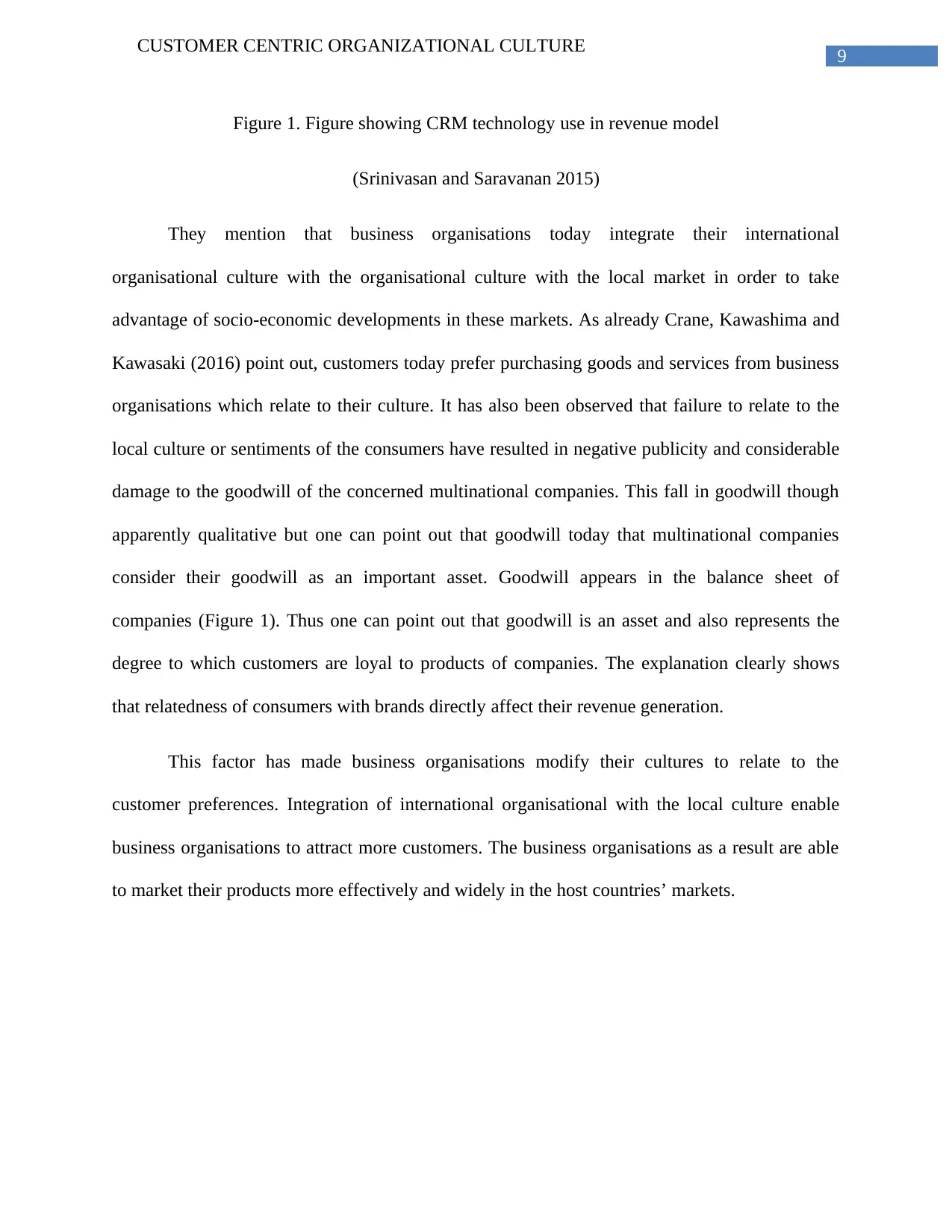
9
CUSTOMER CENTRIC ORGANIZATIONAL CULTURE
Figure 1. Figure showing CRM technology use in revenue model
(Srinivasan and Saravanan 2015)
They mention that business organisations today integrate their international
organisational culture with the organisational culture with the local market in order to take
advantage of socio-economic developments in these markets. As already Crane, Kawashima and
Kawasaki (2016) point out, customers today prefer purchasing goods and services from business
organisations which relate to their culture. It has also been observed that failure to relate to the
local culture or sentiments of the consumers have resulted in negative publicity and considerable
damage to the goodwill of the concerned multinational companies. This fall in goodwill though
apparently qualitative but one can point out that goodwill today that multinational companies
consider their goodwill as an important asset. Goodwill appears in the balance sheet of
companies (Figure 1). Thus one can point out that goodwill is an asset and also represents the
degree to which customers are loyal to products of companies. The explanation clearly shows
that relatedness of consumers with brands directly affect their revenue generation.
This factor has made business organisations modify their cultures to relate to the
customer preferences. Integration of international organisational with the local culture enable
business organisations to attract more customers. The business organisations as a result are able
to market their products more effectively and widely in the host countries’ markets.
CUSTOMER CENTRIC ORGANIZATIONAL CULTURE
Figure 1. Figure showing CRM technology use in revenue model
(Srinivasan and Saravanan 2015)
They mention that business organisations today integrate their international
organisational culture with the organisational culture with the local market in order to take
advantage of socio-economic developments in these markets. As already Crane, Kawashima and
Kawasaki (2016) point out, customers today prefer purchasing goods and services from business
organisations which relate to their culture. It has also been observed that failure to relate to the
local culture or sentiments of the consumers have resulted in negative publicity and considerable
damage to the goodwill of the concerned multinational companies. This fall in goodwill though
apparently qualitative but one can point out that goodwill today that multinational companies
consider their goodwill as an important asset. Goodwill appears in the balance sheet of
companies (Figure 1). Thus one can point out that goodwill is an asset and also represents the
degree to which customers are loyal to products of companies. The explanation clearly shows
that relatedness of consumers with brands directly affect their revenue generation.
This factor has made business organisations modify their cultures to relate to the
customer preferences. Integration of international organisational with the local culture enable
business organisations to attract more customers. The business organisations as a result are able
to market their products more effectively and widely in the host countries’ markets.
Paraphrase This Document
Need a fresh take? Get an instant paraphrase of this document with our AI Paraphraser
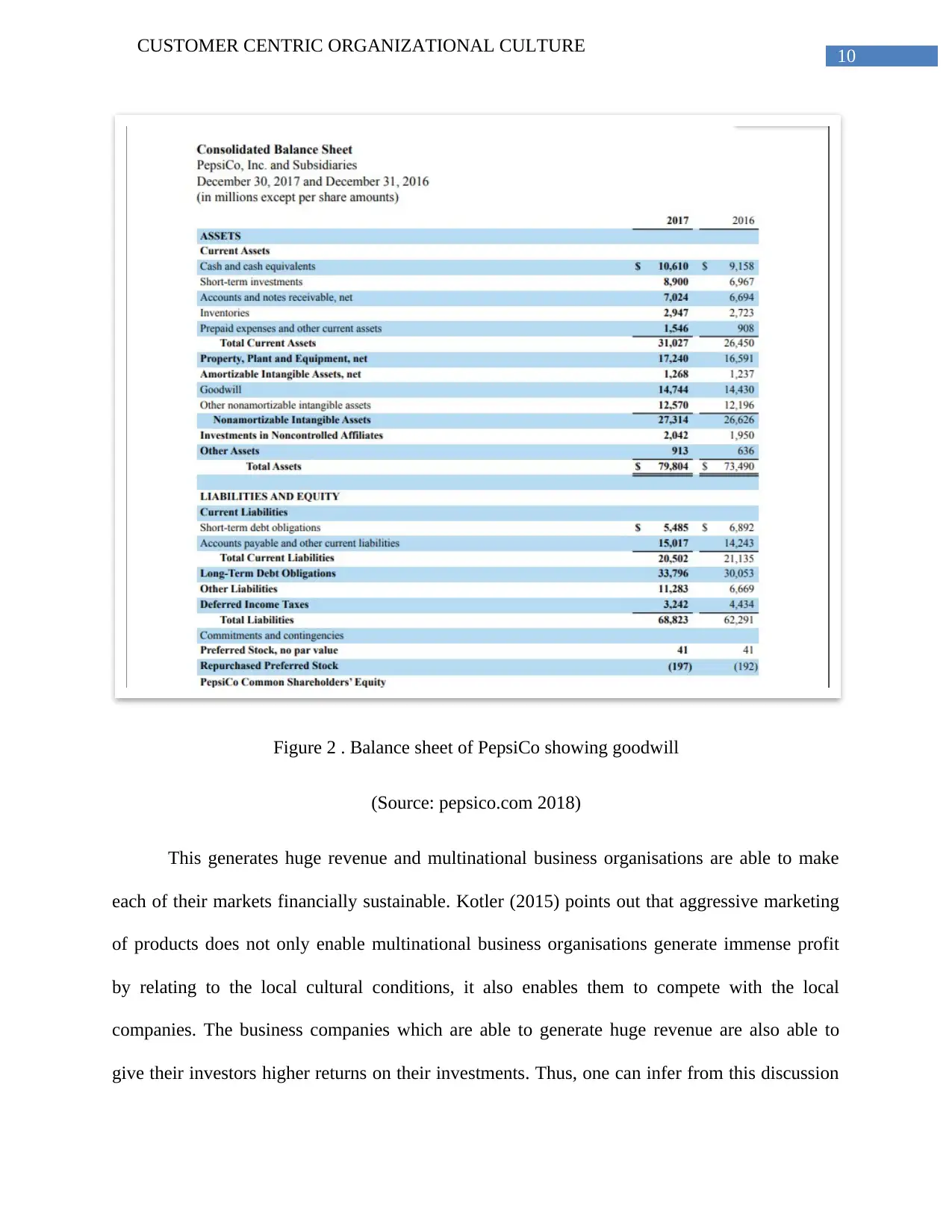
10
CUSTOMER CENTRIC ORGANIZATIONAL CULTURE
Figure 2 . Balance sheet of PepsiCo showing goodwill
(Source: pepsico.com 2018)
This generates huge revenue and multinational business organisations are able to make
each of their markets financially sustainable. Kotler (2015) points out that aggressive marketing
of products does not only enable multinational business organisations generate immense profit
by relating to the local cultural conditions, it also enables them to compete with the local
companies. The business companies which are able to generate huge revenue are also able to
give their investors higher returns on their investments. Thus, one can infer from this discussion
CUSTOMER CENTRIC ORGANIZATIONAL CULTURE
Figure 2 . Balance sheet of PepsiCo showing goodwill
(Source: pepsico.com 2018)
This generates huge revenue and multinational business organisations are able to make
each of their markets financially sustainable. Kotler (2015) points out that aggressive marketing
of products does not only enable multinational business organisations generate immense profit
by relating to the local cultural conditions, it also enables them to compete with the local
companies. The business companies which are able to generate huge revenue are also able to
give their investors higher returns on their investments. Thus, one can infer from this discussion
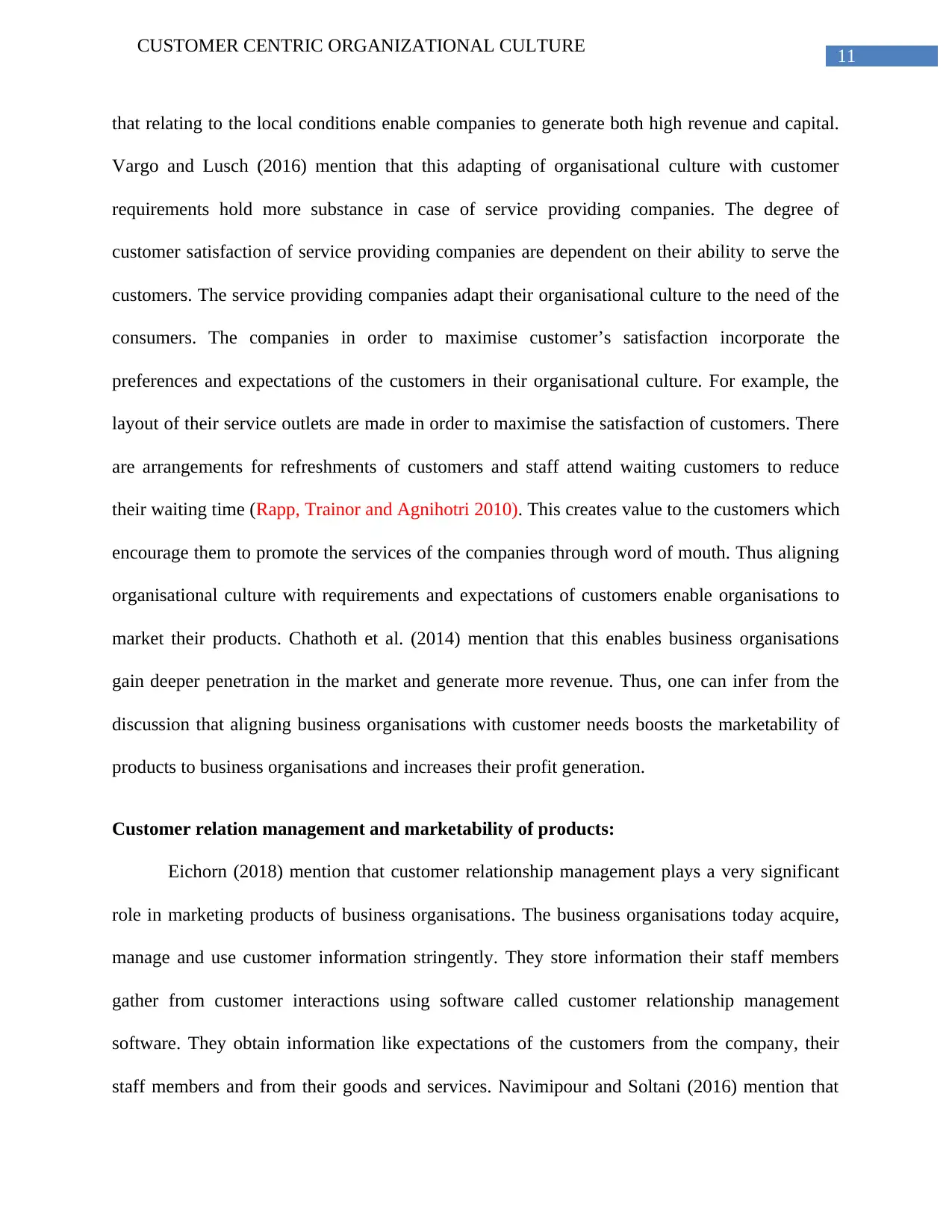
11
CUSTOMER CENTRIC ORGANIZATIONAL CULTURE
that relating to the local conditions enable companies to generate both high revenue and capital.
Vargo and Lusch (2016) mention that this adapting of organisational culture with customer
requirements hold more substance in case of service providing companies. The degree of
customer satisfaction of service providing companies are dependent on their ability to serve the
customers. The service providing companies adapt their organisational culture to the need of the
consumers. The companies in order to maximise customer’s satisfaction incorporate the
preferences and expectations of the customers in their organisational culture. For example, the
layout of their service outlets are made in order to maximise the satisfaction of customers. There
are arrangements for refreshments of customers and staff attend waiting customers to reduce
their waiting time (Rapp, Trainor and Agnihotri 2010). This creates value to the customers which
encourage them to promote the services of the companies through word of mouth. Thus aligning
organisational culture with requirements and expectations of customers enable organisations to
market their products. Chathoth et al. (2014) mention that this enables business organisations
gain deeper penetration in the market and generate more revenue. Thus, one can infer from the
discussion that aligning business organisations with customer needs boosts the marketability of
products to business organisations and increases their profit generation.
Customer relation management and marketability of products:
Eichorn (2018) mention that customer relationship management plays a very significant
role in marketing products of business organisations. The business organisations today acquire,
manage and use customer information stringently. They store information their staff members
gather from customer interactions using software called customer relationship management
software. They obtain information like expectations of the customers from the company, their
staff members and from their goods and services. Navimipour and Soltani (2016) mention that
CUSTOMER CENTRIC ORGANIZATIONAL CULTURE
that relating to the local conditions enable companies to generate both high revenue and capital.
Vargo and Lusch (2016) mention that this adapting of organisational culture with customer
requirements hold more substance in case of service providing companies. The degree of
customer satisfaction of service providing companies are dependent on their ability to serve the
customers. The service providing companies adapt their organisational culture to the need of the
consumers. The companies in order to maximise customer’s satisfaction incorporate the
preferences and expectations of the customers in their organisational culture. For example, the
layout of their service outlets are made in order to maximise the satisfaction of customers. There
are arrangements for refreshments of customers and staff attend waiting customers to reduce
their waiting time (Rapp, Trainor and Agnihotri 2010). This creates value to the customers which
encourage them to promote the services of the companies through word of mouth. Thus aligning
organisational culture with requirements and expectations of customers enable organisations to
market their products. Chathoth et al. (2014) mention that this enables business organisations
gain deeper penetration in the market and generate more revenue. Thus, one can infer from the
discussion that aligning business organisations with customer needs boosts the marketability of
products to business organisations and increases their profit generation.
Customer relation management and marketability of products:
Eichorn (2018) mention that customer relationship management plays a very significant
role in marketing products of business organisations. The business organisations today acquire,
manage and use customer information stringently. They store information their staff members
gather from customer interactions using software called customer relationship management
software. They obtain information like expectations of the customers from the company, their
staff members and from their goods and services. Navimipour and Soltani (2016) mention that
⊘ This is a preview!⊘
Do you want full access?
Subscribe today to unlock all pages.

Trusted by 1+ million students worldwide
1 out of 23
Related Documents
Your All-in-One AI-Powered Toolkit for Academic Success.
+13062052269
info@desklib.com
Available 24*7 on WhatsApp / Email
![[object Object]](/_next/static/media/star-bottom.7253800d.svg)
Unlock your academic potential
Copyright © 2020–2025 A2Z Services. All Rights Reserved. Developed and managed by ZUCOL.





